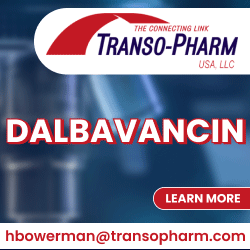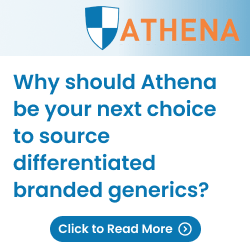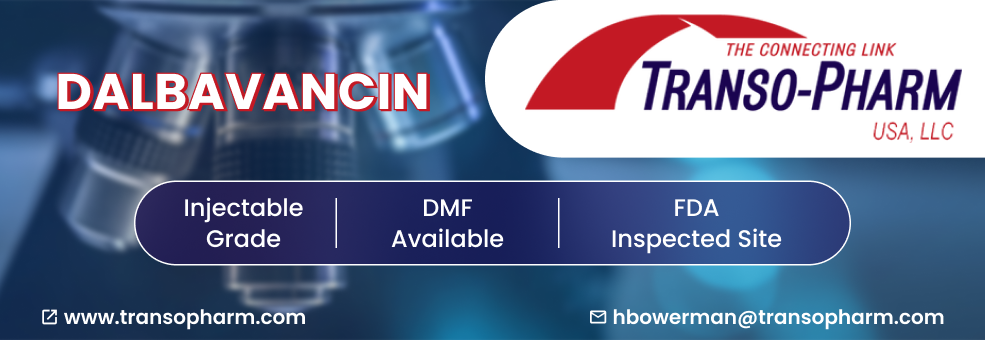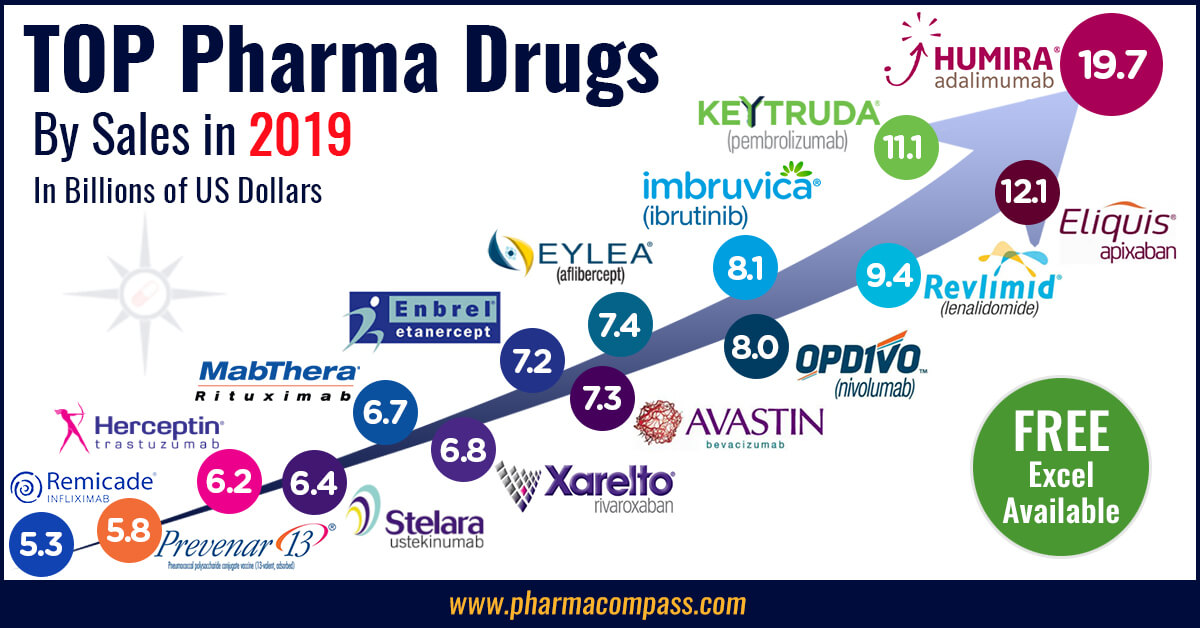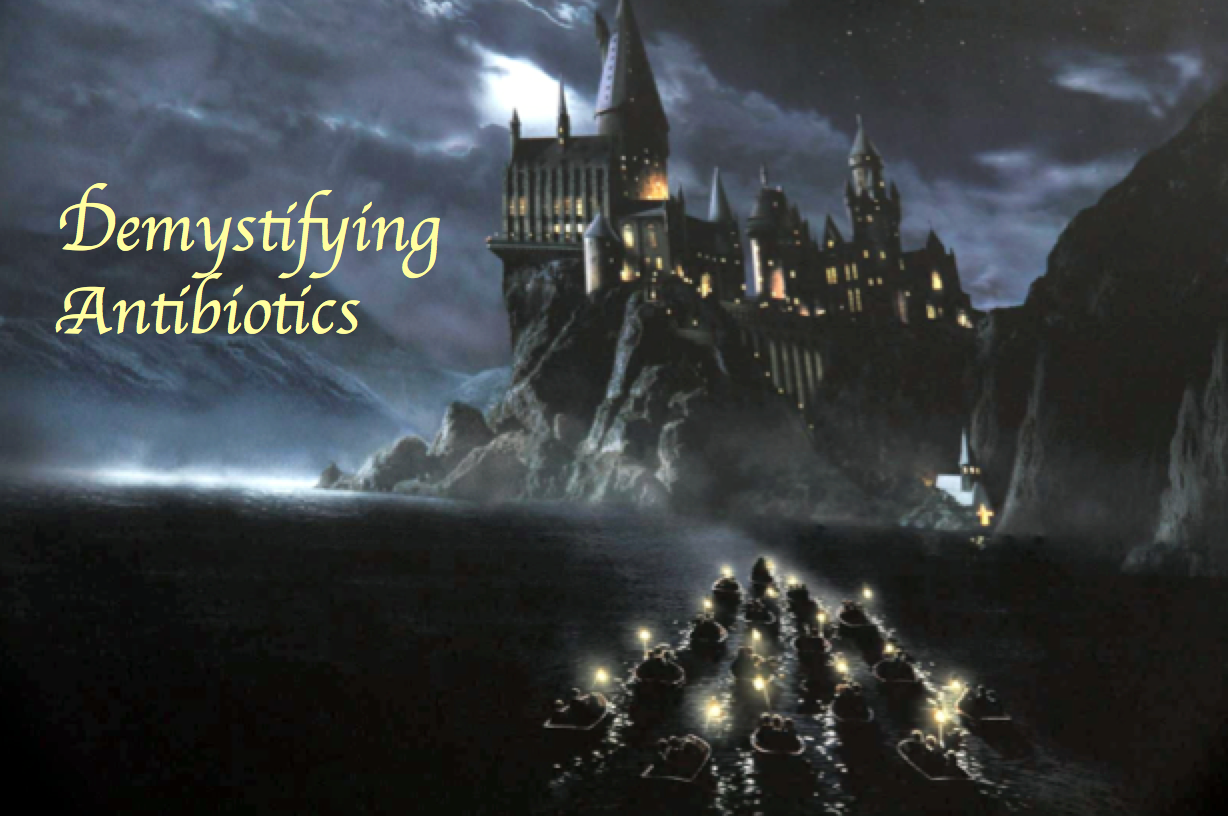Acquisitions and spin-offs dominated headlines in 2019 and the tone was set very early with Bristol-Myers Squibb acquiring
New Jersey-based cancer drug company Celgene in a US$ 74 billion deal announced on
January 3, 2019. After factoring
in debt, the deal value ballooned to about US$ 95 billion, which according
to data compiled by Refinitiv, made it the largest healthcare deal on
record.
In the summer, AbbVie Inc,
which sells the world’s best-selling drug Humira, announced its acquisition of Allergan Plc, known for Botox and other cosmetic
treatments, for US$ 63 billion. While the companies are still awaiting
regulatory approval for their deal, with US$ 49 billion in combined 2019
revenues, the merged entity would rank amongst the biggest in the industry.
View Our Interactive Dashboard on Top drugs by sales in 2019 (Free Excel Available)
The big five by pharmaceutical sales — Pfizer,
Roche, J&J, Novartis and Merck
Pfizer
continued
to lead companies by pharmaceutical sales by reporting annual 2019 revenues of
US$ 51.8 billion, a decrease of US$ 1.9 billion, or 4 percent, compared to
2018. The decline was primarily attributed to the loss of exclusivity of Lyrica in 2019,
which witnessed its sales drop from US$ 5 billion in 2018 to US$ 3.3 billion in
2019.
In 2018, Pfizer’s then incoming CEO Albert Bourla had mentioned that the company did not see the need for any large-scale M&A activity as Pfizer had “the best pipeline” in its history, which needed the company to focus on deploying its capital to keep its pipeline flowing and execute on its drug launches.
Bourla stayed true to his word and barring the acquisition of Array Biopharma for US$ 11.4 billion and a spin-off to merge Upjohn, Pfizer’s off-patent branded and generic established medicines business with
Mylan, there weren’t any other big ticket deals which were announced.
The
Upjohn-Mylan merged entity will be called Viatris and is expected to have 2020
revenues between US$ 19 and US$ 20 billion
and could outpace Teva to
become the largest generic company in the world, in term of revenues.
Novartis, which had
followed Pfizer with the second largest revenues in the pharmaceutical industry
in 2018, reported its first full year earnings after spinning off its Alcon eye
care devices business division that
had US$ 7.15 billion in 2018 sales.
In 2019,
Novartis slipped two spots in the ranking after reporting total sales of US$
47.4 billion and its CEO Vas Narasimhan continued his deal-making spree by buying New
Jersey-headquartered The Medicines Company (MedCo) for US$ 9.7
billion to acquire a late-stage cholesterol-lowering
therapy named inclisiran.
As Takeda Pharmaceutical Co was
busy in 2019 on working to reduce its debt burden incurred due to its US$ 62
billion purchase of Shire Plc, which was announced in 2018, Novartis also purchased
the eye-disease medicine, Xiidra, from the Japanese drugmaker for US$ 5.3 billion.
Novartis’ management also spent a considerable part of 2019 dealing with data-integrity concerns which emerged from its 2018 buyout of AveXis, the
gene-therapy maker Novartis had acquired for US$ 8.7 billion.
The deal gave Novartis rights to Zolgensma,
a novel treatment intended for children less than two years of age with the
most severe form of spinal muscular atrophy (SMA). Priced at US$ 2.1 million,
Zolgensma is currently the world’s most expensive drug.
However,
in a shocking announcement, a month after approving the drug, the US Food and
Drug Administration (FDA) issued a press release on
data accuracy issues as the agency was informed by AveXis that
its personnel had manipulated data which
the FDA used to evaluate product comparability and nonclinical (animal)
pharmacology as part of the biologics license application (BLA), which was
submitted and reviewed by the FDA.
With US$
50.0 billion (CHF 48.5 billion) in annual pharmaceutical sales, Swiss drugmaker
Roche came in at number two position in 2019
as its sales grew 11 percent driven by
its multiple sclerosis medicine Ocrevus, haemophilia drug Hemlibra and cancer medicines Tecentriq and Perjeta.
Roche’s newly introduced medicines generated US$ 5.53 billion (CHF 5.4 billion) in growth, helping offset the impact of the competition from biosimilars for its three best-selling drugs MabThera/Rituxan, Herceptin and Avastin.
In late 2019, after months of increased
antitrust scrutiny, Roche completed
its US$ 5.1 billion acquisition of Spark Therapeutics to strengthen its presence in
gene therapy.
Last year, J&J reported almost flat worldwide sales of US$ 82.1 billion. J&J’s pharmaceutical division generated US$ 42.20 billion and its medical devices and consumer health divisions brought in US$ 25.96 billion and US$ 13.89 billion respectively.
Since J&J’s consumer health division sells analgesics, digestive health along with beauty and oral care products, the US$ 5.43 billion in consumer health sales from over-the-counter drugs and women’s health products was only used in our assessment of J&J’s total pharmaceutical revenues. With combined pharmaceutical sales of US$ 47.63 billion, J&J made it to number three on our list.
While the sales of products like Stelara, Darzalex, Imbruvica, Invega Sustenna drove J&J’s pharmaceutical business to grow by 4 percent over 2018, the firm had to contend with generic competition against key revenue contributors Remicade and Zytiga.
US-headquartered Merck, which is known as
MSD (short for Merck Sharp & Dohme) outside the United States and
Canada, is set to significantly move up the rankings next year fueled by its
cancer drug Keytruda, which witnessed a 55
percent increase in sales to US$ 11.1 billion.
Merck reported total revenues of US$ 41.75 billion and also
announced it will spin off its women’s health drugs,
biosimilar drugs and older products to create a new pharmaceutical
company with US$ 6.5 billion in annual revenues.
The firm had anticipated 2020 sales between US$ 48.8 billion and US$ 50.3 billion however this week it announced that the coronavirus pandemic will reduce 2020 sales by more than $2 billion.
View Our Interactive Dashboard on Top drugs by sales in 2019 (Free Excel Available)
Humira holds on to remain world’s best-selling drug
AbbVie’s acquisition of Allergan comes as the firm faces the expiration of patent protection for Humira, which brought in a staggering US$ 19.2 billion in sales last year for
the company. AbbVie has failed to successfully acquire or develop a major new
product to replace the sales generated by its flagship drug.
In 2019, Humira’s US revenues increased 8.6 percent to US$ 14.86 billion while internationally, due
to biosimilar competition, the sales dropped 31.1 percent to US$ 4.30 billion.
Bristol Myers Squibb’s Eliquis, which is also marketed by Pfizer, maintained its number two position
and posted total sales of US$ 12.1 billion, a 23 percent increase over 2018.
While Bristol Myers Squibb’s immunotherapy treatment Opdivo, sold in partnership with Ono in Japan, saw sales increase from US$ 7.57 billion to US$ 8.0 billion, the growth paled in comparison to the US$ 3.9
billion revenue increase of Opdivo’s key immunotherapy competitor Merck’s Keytruda.
Keytruda took the number three spot in drug sales that
previously belonged to Celgene’s Revlimid, which witnessed a sales decline from US$ 9.69 billion to US$ 9.4 billion.
Cancer treatment Imbruvica, which is marketed
by J&J and AbbVie, witnessed a 30 percent increase in sales. With US$ 8.1
billion in 2019 revenues, it took the number five position.
View Our Interactive Dashboard on Top drugs by sales in 2019 (Free Excel Available)
Vaccines – Covid-19 turns competitors into partners
This year has been dominated by the single biggest health emergency in years — the novel coronavirus (Covid-19) pandemic. As drugs continue to fail to meet expectations, vaccine development has received a lot of attention.
GSK reported the highest vaccine sales of all drugmakers with
total sales of US$ 8.4 billion (GBP 7.16 billion), a significant portion of its
total sales of US$ 41.8 billion (GBP 33.754 billion).
US-based Merck’s vaccine division also reported a significant increase in sales to US$ 8.0 billion and in 2019 received FDA and EU approval to market its Ebola vaccine Ervebo.
This is the first FDA-authorized vaccine against the deadly virus which causes
hemorrhagic fever and spreads from person to person through direct contact with
body fluids.
Pfizer and Sanofi also reported an increase in their vaccine sales to US$ 6.4
billion and US$ 6.2 billion respectively and the Covid-19 pandemic has recently
pushed drugmakers to move faster than ever before and has also converted
competitors into partners.
In a rare move, drug behemoths — Sanofi and GlaxoSmithKline (GSK) —joined hands to develop a vaccine for the novel coronavirus.
The two companies plan to start human trials
in the second half of this year, and if things go right, they will file
for potential approvals by the second half of 2021.
View Our Interactive Dashboard on Top drugs by sales in 2019 (Free Excel Available)
Our view
Covid-19 has brought the world economy to a grinding halt and shifted the global attention to the pharmaceutical industry’s capability to deliver solutions to address this pandemic.
Our compilation shows that vaccines and drugs
for infectious diseases currently form a tiny fraction of the total sales of
pharmaceutical companies and few drugs against infectious diseases rank high on
the sales list.
This could well explain the limited range of
options currently available to fight Covid-19. With the pandemic currently infecting
over 3 million people spread across more than 200 countries, we can safely
conclude that the scenario in 2020 will change substantially. And so should our
compilation of top drugs for the year.
View Our Interactive Dashboard on Top drugs by sales in 2019 (Free Excel Available)
Impressions: 54763
Researchers at the University of Nottingham’s Centre for Biomolecular Sciences have demonstrated that Bald’s Leechbook, an Old English leather-bound manuscript, has a one thousand year old Anglo-Saxon remedy for eye infections, which can kill the modern-day superbug Methicillin-Resistant Staphylococcus Aureus (MRSA).
The remedy, verified in university labs
in both the United States and United Kingdom, worked better than the current
gold standard for MRSA flesh infections, the antibiotic vancomycin.
With our past analysis varying from ‘APIs urgently needed in US and Canada’ to ‘Are assessments of foreign regulatory (USFDA
& EDQM) inspections fair?’,
one might wonder why focus on spinning tales like Harry Potter... Well, the
answer could be worth $100 trillion!
Antibiotics, those boring commodity
molecules, which humans consumed more than
3 million kg of in 2009, and animals were fed almost 13 million kg in 2010, have
now started gaining global attention due to concerns of antibiotic
resistance.
How
serious is the focus and how bad is the concern?
2012 -
Law passed in the United States, commonly known as the GAIN Act, or the Generating Antibiotics Incentives Now Act, to help stimulate the development of new antibiotics to treat serious or life-threatening infections. Under the GAIN Act, certain antibacterial or antifungal drugs can be designated as “Qualified Infectious Disease Products” (QIDPs), which allows the drug to get priority
review, eligibility for fast track designation and the possibility of an
additional five years of marketing exclusivity.
April 2014 - WHO’s first
global report on antibiotic resistance in 114 countries reveals a serious, worldwide threat to public health. The loss of effectiveness of antibiotics can create a “post-antibiotic era” in which, common infections could become deadly again.
December 2014 - Former Goldman Sachs chief economist, Jim O'Neill, chairs UK report, which warns that failure to tackle the antibiotic resistance problem, will make it bigger than cancer by 2050 on one hand, will also cost the global economy up to $100 trillion, and could cause at least 10 million extra deaths a year.
March 2015 - The White House releases a five year - $1.2 billion National Action Plan, for combating antibiotic resistant bacteria. The fight is officially declared a “national security priority”.
Recognizing the multiple challenges
faced due to antibiotic resistance, the USFDA & Center of Disease Control
have launched a partnership, the Get
Smart Campaign, which seeks to ensure that patients get the right
antibiotic at the right dose for the right amount of time.
However, studies are now beginning to show
that the problem is spiraling out of control, since it is more than just an
antibiotics prescription issue.
Earlier this month, analysis of urine
samples of almost 60% of over 1000 school children in China, were
found to contain antibiotics. As the tested antibiotics have been clinically discontinued, the most likely source of exposure is the food and the environment.
In addition to the China schoolchildren
study, a Swedish
study around Hyderabad (the heart of the Indian pharmaceutical industry), found a number of drugs contaminating the water, some in concentrations higher than in patients’ blood.
As antibiotic production is heavily polluting,
the residual traces of antibiotics in the waste water are also responsible for
growing antibiotic resistance in many areas.
So while governments continue to battle with the major health challenge of antibiotic resistance, the entire supply chain is currently linked to China, where the environmental concerns are continuing to grab attention of local authorities.
The United States is almost
completely reliant on China for its supply of life-saving antibiotics; India, the world's pharmaceutical factory, imports 80% of its
bulk drugs from China; it is worth wondering how a cooperative, global solution
will be arrived at.
While the Indian government is promoting
self-sufficiency of antibiotic supply, by trying to revive the almost defunct
Hindustan Antibiotics Limited (HAL), the challenges faced are gigantic.
So
how are the scientists and industry helping?
Companies are actively developing
new antibiotics and there are many in the pipeline, however "of the 32
or so companies with antibiotics in clinical development today, only five rank
among the top 50 pharmaceutical companies by sales."
In June 2014, Actavis
acquired Durata
Therapeutics for about $675 million to get their lead product DALVANCE (dalbavancin),
the first drug approved as a QIDP. Merck
followed suit in December by acquiring
Cubist
Pharmaceuticals, a company specializing in developing treatments for
superbugs for $9.5 billion.
The Medicines Company is the only company left with an approved new antibiotic that has not been acquired by Big Pharma. Their antibiotic Oritavancin,
has Orange Book patent expiries starting in 2015 but exclusivities are valid
until 2019.
A team from Northeastern University
along with others, earlier this year, published a paper in Nature on a new
antibiotic, Teixobactin, which has a novel mechanism
of action and is a new discovery technology platform. This is the first big
antibiotic breakthrough in decades. Under accelerated regulatory approval the
molecule will take about five years to reach the clinic.
Our ‘Phisper’:
While everybody is trying new, innovative solutions to address this global problem, you can consider the “Ancientbiotic” way from Bald's Leechbook. It is after all, widely thought of as one of the earliest known medical textbooks, and contains Anglo-Saxon medical advice and recipes for medicines, salves and treatments.
The simple eye salve used by the researchers contains two species of Allium (garlic and onion or leek), wine and oxgall (bile from a cow's stomach) brewed in a brass vessel. The ingredients are pounded together and left to stew for days. The resulting mash kills germs as well as germs that form a sticky mess called a biofilm; modern antibiotics find this difficult to achieve.
If you wish to get ahead, contact Dr
Christina Lee, the Anglo-Saxon expert from the School of English who enlisted the help of microbiologists from the University’s Centre for Biomolecular Sciences to recreate the 10th century science... She is looking for funding support!
Impressions: 3230
Unless you are like Voltaire and think that “The art of medicine consists of amusing patients while nature cures the disease”, you will be thrilled with the new drugs approval (NDAs) list of the FDA: about 40 new drugs in 10 therapeutic areas! It has been 18 years since the FDA approved so many new drugs, so let’s quickly take a tour at the Olympic podium:
OLYMPIC PODIUM
The golden medal comes to AstraZeneca with 4 NDAs: Farxiga (diabetes), Movantik (constipation), Lynparza (ovarian cancer) and Myalept (lipodystrophy, also called fat reduction, which is common in patients with HIV and AIDS).
Then come the silver medals with 3 NDAs each:
Biogen Idec with Alprolix (hemophilia B), Eloctate (hemophilia A), Plegridy (multiple sclerosis).
Lilly with Cyramza (gastric cancer), Jardiance (diabetes), Trulicity (diabetes).
Merck&Co with Zontivity (coronary artery disease), Belsomra (insomnia), Keytruda (melanoma).
And the bronze medals with 2 NDAs each:
Boehringer-Ingelheim with Striverdi Respimat (chronic obstructive pulmonary disease), Ofev (idiopathic pulmonary fibrosis).
Cubist with Sivextro (skin infection), Zerbaxa (urinary and abdominal infections).
Gilead with Zydelig (leukemia), Harvoni (hepatitis C –“first combination pill approved to treat chronic hepatitis C virus genotype 1 infection and the first approved regimen that does not require administration with interferon or ribavirin”).
Novartis with Xtoro (acute otitis externa), Zykadia (lung cancer).
THERAPEUTIC AREAS
In terms of therapeutic areas, infectious diseases come first with 27% of the NDAs, followed by cancer with 18% and then rare diseases with 11% according to Forbes. Knowing that a disease is classified as ‘rare’ when it affects 200,000 people maximum in the US, the pharmaceutical industry and the FDA have done a fantastic job because overall it is 25 millions American whom are concerned by orphan diseases. And how many more around the world?
According to EvaluatePharma, in 2020 orphan drugs are expected to account for 19% of the total share of prescription drug sales excluding generics, reaching $176 billion in annual sales in America alone.
Here are the main NDAs 2014 for rare diseases:
Amgen with Blincyto (Philadelphia chromosome-negative precursor B-cell acute lymphoblastic leukemia- leads to cancer).
Anacor with Kerydin (fungal infection).
BioCryst with Rapivab (influenza- infectious disease caused by the influenza virus).
Biomarin with Vimizim (Morquio A syndrome- the body is missing or doesn't have enough of a substance needed to break down long chains of sugar molecules).
Boehringer-Ingelheim with Ofev (idiopathic pulmonary fibrosis).
Chelsea with Northera (neurogenetic orthostatic hypotension- often associated with Parkinson’s disease).
Hoffman la Roche with Esbriet (idiopathic pulmonary fibrosis).
Johnson & Johnson with Sylvant (multicentric Castleman’s disease- involves hyper activation of the immune system).
Paladin with Impavido (leishmaniasis- disease caused by protozoan parasites).
Sanofi with Cerdelga (Gaucher’s disease- genetic disease in which fatty substance accumulate in cells and certain organs).
Spectrum with Beleodaq (non-Hodgkin lymphoma- group of blood cancers that includes any kind of lymphoma except Hodgkin's lymphomas).
Takeda with Entyvio (ulcerative colitis ; Crohn’s disease- inflammatory disease that affects any part of the gastrointestinal tract from mouth to anus)
Valeant with Jublia (fungal infection).
Vanda with Hetlioz (non stop 24 hour sleep wake disorder).
The huge impact after the release of the 2014 NDAs list was the pharma exchange-traded funds flared up (Nasdaq Biotechnology Index and S&P 500 Health Care Index 34 percent and 23 percent respectively.
However, finance is not everything, as we have all learned during the 2008 financial crisis, and NDAs are not the only conditions for a new strategy to success anymore, as proven by a lot of pharmaceutical companies in the past years who haven’t achieved enough revenues despite NDAs.
It seems that pricing is going to be key as competition is becoming fiercer. Look at the 2014 NDAs batch for anti bacterial drugs to treat skin infections; 3 brand new drugs for this year only.
Cubist with Sivextro
Durata with Dalvance
The Medecine Companies with Orbactiv
Same for the idiopathic pulmonary fibrosis as we just saw in the rare diseases approval list above: 2 NDAs for 2014. According to Fierce Pharma, there are 8 therapeutic areas where competition is going to be even fiercer in the future: hepatitis C, diabetes, cholesterol, hemophilia, hemo-oncology, psoriasis, melanoma and obesity.
And it is not like patents are not going to continue dropping; generics represent now more than 40% of the products sales. Moreover, premium prices following NDAs have been implicating confrontations with insurers and governments in regards to diabetes and respiratory drugs in the past.
Therefore, new tactics have to be found!
AbbVie offered their new anti hepatitis C drug, Viekira Pak, at a discount price to Express Script (the largest pharmacy benefit management organization in the United States) for an exclusive distribution. Even if Viekira Pak is said to be a less convenient dosing regiment when compared to Gilead’s anti hepatitis C drug (Sovaldi), the deal was closed as Sovaldi’s premium price actually chocked the payers. It is a perfect move for AbbVie, who just lost their patent on one of their main drug: Humira (rheumatoid arthritis).
Biotech are said to be an excellent area for successful strategy as well.
If there is more success at R&D projects (as it looks to be the case in the biotech field) then R&D department cost less and the overall financial risk should be lowered.
Here are the main NDAs 2014 for biotech/ cancer:
Baxter with Obizur (hemophilia).
Biogen Idec with Plegridy (multiple sclerosis), and Alprolix and Eloctate (hemophilia).
Celgene with Otezla (psoriasis)
Gilead with Zydelig (anti-cancer treatment).
Helsinn with Akynzeo (emesis- prevent nausea and vomiting caused by cancer drug treatment).
Salix with Ruconest and Pfizer with Trumenba (meningitides type B).
Bristol-Myers Squibb with Opdivo (melanoma) and Merck & Co with Keytruda (melanoma as well), which work by blocking a protein called Programmed Death receptor (PD-1), are the first in a coming wave of immunotherapies and are said to have the potential of generating more than 30 million USD/ year.
So in case all these new strategies don’t work and definitely become a financial matter only instead of a medical focus to help the world to live a little better, don’t forget to “always laugh when you can, it is cheap medicine” as George Gordon Byron liked to advise.
Impressions: 2361







